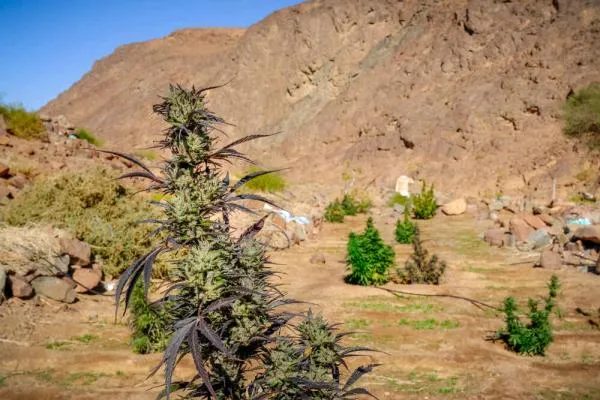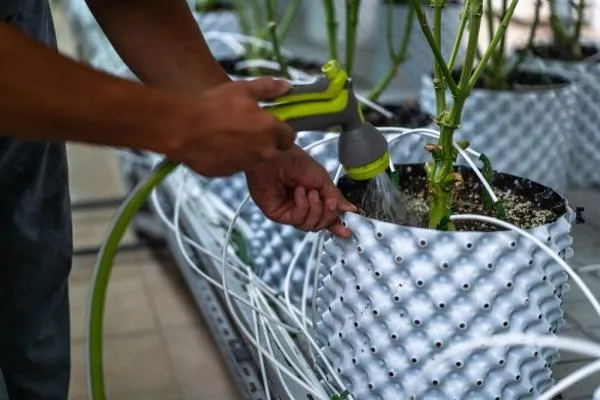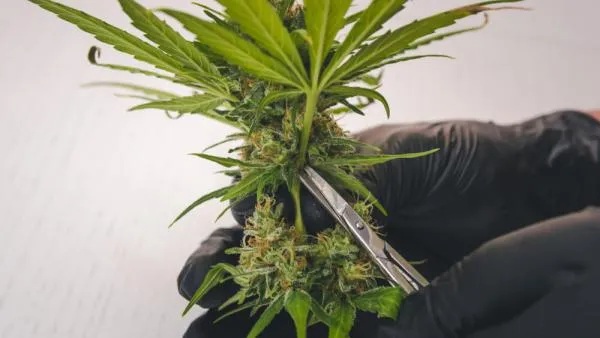The debate over soil-grown vs. hydroponically grown weed is perhaps one of those topics that will never be conclusively settled. Both grow methods have their advantages and disadvantages, though hydroponics can be more challenging, particularly from a technical angle and especially for beginners. However, the results from growing hydroponically can be very rewarding. This begs the question ‘Is there a right way to grow weed using hydroponics?’. Of course, there is a right and wrong method of doing anything and hydroponic cannabis cultivation is no exception. Having said that, it is not as difficult as newbies might think. In fact, there are plenty of ways to make hydroponic gardens easy and fun enough, even for novice growers. Feel like you’d be up to the task? Well then keep reading as we are about to show you how newcomers to the hydroponic method can have a successful harvest.
- What is hydroponics growing?
- What are the pros and cons of hydroponic weed growing?
- Is hydro or soil better for weed?
- What’s the difference between active and passive hydro systems?
- What are the best growing mediums for hydroponic grows?
- What is the best hydroponics system for beginners?
- How to grow weed using the DWC system (include an equipment list)
- Should you flush hydroponic weed?
- Does hydroponics increase yield?
- How fast does hydro weed grow?
- What cannabis strains perform best in hydroponics?
- Summary
What is hydroponics growing?
Hydroponics is actually a growing method with a very long history particularly in the Ancient Far East and other areas where large civilizations have come and gone. Used mainly for growing rice, in its essence, it involves feeding and supplying plants with nutrients and a good amount of aeration to the roots without the use of an organic, living medium such as soil.
When using soil, nutrients are absorbed by the plant’s roots at a much slower rate. With hydroponics, you take out the middle-man and feed nutrients directly to plant roots through a water-based solution, thus making the feeding and growing process much faster. For millennia this technique has been used for staple crops such as rice but also for fruits and vegetables (such as strawberries and tomatoes) as well as flowers of all kinds. With the explosion in home-growing popularity and technology, hydroponic gardening also quickly spread among growers in the cannabis community and remains a popular method around the globe to this day due to its ability to grow plants with impressive yields.
What are the pros and cons of hydroponic weed growing?
No system is perfect, and every grow method will have its pluses and minuses with respect to other techniques. This equally applies to hydroponics. So, what makes hydroponic gardening so popular among growers today? The most common reasons for choosing hydroponics are speed and yields. On average, hydroponic gardens tend to grow 30-50% faster than soil gardens and yields are also noticeably bigger.
Since there is no organic medium for nutrients to filter through first, roots are fed immediately upon contact with water and plants take less time to bulk up. As they are getting regularly fed, plants can direct all of their energy towards growth. In addition to faster and bigger yields, hydroponic gardens are also a little easier to physically set up as they don’t require any heavy soil and plants can be grown in smaller pots/containers.
There is a bit of a trade-off with having a simpler setup however. In soil gardens, the organic medium will act as a buffer and will help regulate nutrient imbalances, whereas with hydroponics everything is in the grower’s hands. This means that the grower must regularly pay careful attention to the plant’s nutrient demands. While things such as over-watering won’t occur in a hydro setup, pH and nutrient levels still must be monitored. With an automated system though, it is much easier to keep pH and nutrient levels in check, making the risk of things like nutrient lockup that much lower.
Is hydro or soil better for weed?
For years there has been a debate among growers; soil vs hydro, which is best for weed? Well the answer is that it is down to personal preference. Many connoisseurs and traditionalists prefer the organic soil method for its flavor profile as well as the effects. Terpenes play a vital role in terms of the flavor and aroma of cannabis and it is microbes in soil that drive terpene production. While terpenes are found in all cannabis plants, critics will usually say that hydroponically grown weed is usually lacking in terms of taste and effect compared to quality outdoor organic bud.
If you have an all-organic outdoor garden with living soil or some permaculture setup, your crop will definitely different than compared to a hydro setup. The contents of your outdoor garden (i.e. all the soil microbes, worms, insects, predators, etc.) will influence the way your plants interact with their surroundings. This in turn will affect how the plant phenotypes (color, cannabinoid/terpene content, plant height, scent, etc.) will be expressed. If you are in an indoor setup where you control the lighting, the nutrients and any potential pests, your crop will also end up quite different. For those interested in the phenotypes of a given variety, this might be an issue, however if you are growing for commercial purposes, in other words your goal is WEIGHT, this doesn’t play much of a role.
What’s the difference between active and passive hydro systems?
Passive vs. active in terms of hydroponics refers to the method of getting nutrient solution to the plants’ roots. In active systems, fresh nutrient solution is moved from a reservoir to the roots through the use of pumps and is usually oxygenated using air stones. Over the years ambitious growers have developed many lots of innovative methods of growing weed hydroponically, such as deep water culture (DWC), drip, ebb and flow, nutrient film technique (NFT) and aeroponics.
Passive systems are much simpler and low-tech in their design and will usually involve capillary action for getting nutrient solution to plant roots. The use of water creates tension, which pulls up as much water as needed to roots, much like a paper towel draws towards the top. There is also a third method that combines hydroponics with nutrient-less planting mixes known as fertigation. This is where an inorganic medium (such as peat moss and vermiculite/perlite mixes) is used to house the plant while the feeding is done either manually or automatically, though capillary mats are most commonly used.
What are the best growing mediums for hydroponic grows?

Pebbles, coco, rock wool give a brief explanation on each – which of these is best for beginners?
Just like the number of different cannabis growing techniques, the number of potential hydroponic growing media can seem overwhelmingly endless. The good news is that there is a short list of reliable yet simple (as well as cheap) media for your hydro grow to choose from.
Clay Pebbles
One of the most popular choices among hydro growers is something known as LECA (lightweight expanded clay aggregate) or clay pebbles. These pebbles don’t contain any nutrients (pH neutral) but thanks to their semi-porosity, they expand when water is added. They are a good option for beginners as they are inexpensive and can be found at any home & garden store. They are great for keeping your plant roots aerated, which means less chance of root rot and plant pests.
Coco Coir
Another popular option among hydro growers is coco coir (aka coco peat), which is made from the inner fibers and pith of coconuts. The fibers do a great job of absorbing water but they also provide a buffer against nutrient fluctuations and resist decomposition due to their high lignin content. In addition to water retention and root aeration, coco coir also mixes well with other planting mediums and is relatively inexpensive.
Vermiculite
Perlite/vermiculite are both lightweight processed minerals that are used for holding water, buffering nutrients, and aerating roots. The minerals are heated until they expand, somewhat similar to popcorn, and take on their new forms, which provide oxygen to roots and promote drainage. Both perlite and vermiculite mix well with other mediums such as coco.
Rockwool Cubes
Last but certainly not least are the ever-present rockwool cubes. Used not just for hydroponics (rockwool is also frequently used in cloning and for germination), they can be found in many different cannabis gardens as they are convenient, cheap and effective. Basalt and chalk are melted and then spun to obtain hair-like fibers much like cotton candy and then are processed into a wide array of different shapes and sizes. They are arranged into rows on larger slabs and can be easily separated according to need. In addition to being sterile, rockwool also holds both air and water so your plants automatically get what they need.
What is the best hydroponics system for beginners?
This of course depends on the user and the available resources. Some systems, such as passive wick systems, are easier to setup while others, such as fully automated ebb and flow rigs take considerable effort to put together but are easier to operate. A good middle ground for a beginner growing cannabis seeds hydroponically would be to use a deep water culture system as they aren’t too difficult to construct, though some effort is involved, and aren’t terribly difficult to operate, though some maintenance is required.
In short, involves keeping the plant roots immersed in a nutrient solution that is constantly aerated/oxygenated. The root balls of the plants are kept in an inorganic medium such as rockwool cubes or clay pebbles suspended in baskets just above the water level in a reservoir containing nutrient solution. As the plant grows, the roots reach further down into the oxygen-rich solution where they have direct and easy access to air, water and food. This turbo-charges plant growth resulting not just in huge crops but also much faster harvest times.
The downside to DWC (or any other hydro system for that matter) is plant sensitivity to nutrient imbalances and/or diseases. Since hydroponic grow substrates such as rockwool or pellets do not have nutrient buffering properties, any imbalances will quickly effect the whole garden, which means growers have to keep a watchful eye on their plants in case any negative health effects need correcting.
How to grow weed using the DWC system (include an equipment list)
A step-by-step approach to growing using this hydro system. You can break it down as 1, 2 3… or if you feel its fits better you can break it down by seedling stage, vegetative stage, flowering stage.
DWC systems are relatively simple to setup and operate but the rewards will be more than satisfying if all goes well. To get started, gather your materials. You will need:
- A large plastic bucket/reservoir (3-5 gallons/11-19 liters).
- A hard plastic lid/flowerpot drain to cover the reservoir.
- At least 1 hydro basket (or however many plants you will grow) 8” (20 cm) in diameter.
- Clay pebbles/LECA/rockwool cube to place in basket.
- An air stone/bubbler with pump and tubing.
- An aquarium heater to keep water at around 70° F (20° C).
- Cut a hole in the plastic lid/drainage tray large enough to fit your basket and drill a small hole (about 1/4 inch in size) to slide the air pump tubing through.
- Slide the tubing through the lid and attach bubbler to one end placed inside the bucket/reservoir along with aquarium heater. Attach air pump to the other loose end outside of the reservoir.
- Fill the reservoir with water and pH-adjusted nutrient solution to just below the tray (4 inches/10 cm) so that roots aren’t fully submerged. Don’t forget to test the pH before submerging plant roots.
- Place tray/lid over the reservoir and fit the basket(s) into the lid so that the planting medium is below the surface of the lid.
- Plug in and turn on pump, bubbler and water heater.
Voila! You now have a basic DWC hydroponic feeding system that should produce a nice big harvest in record time. However do not forget the other elements required for your grow up, specifically lighting, ventilation and odor control if necessary. As far as making adjustments based on the plant growth stage is concerned, you won’t have to make many changes to your setup overall. Whether you are going to buy cannabis online or use clones, the process will remain the same throughout the seedling, veg and flowering stages, at least as far as your hydroponic setup is concerned. The only variations might come in the form of nutrient solution amendments. Since your plant roots will have direct access to abundant amounts of nutrients, the growth stages will pass faster than with a soil garden. All you need to do is make sure your plants are getting the right amount of nutes for the respective growth stage they are in.

Should you flush hydroponic weed?
At least as far as hydroponics are concerned, generally speaking, you should flush before harvesting. Flushing is a hotly debated topic as some regard it as absolutely necessary if you want to harvest quality buds, others claim it is a waste of money as you are literally flushing away all of those expensive nutrients you bought not too long ago. If you are using a super soil where no additional fertilizers or supplements needed to be added, then flushing is indeed a waste of your money. If however you’ve been using a fair amount of liquid or powder nutrients throughout your grow, some minerals may build up in the plant tissue and can leave an unpleasant ‘chemical’ taste if not flushed before harvest.
For hydro setups, particularly DWC, flushing is recommended for about 3 days before harvest. Simply replace the nutrient solution with pH-balanced nutrient-free (i.e. distilled) water. Your plants will still have enough nutrients stored in them from previous feedings to survive the last few days before harvest. This way any unwanted minerals that might leave a salty or bitter taste will get removed and your buds will be all the sweeter and smoother tasting.
Does hydroponics increase yield?
Simply put, yes. Provided you know what you are doing of course! In scientific terms, hydroponics offers a larger yield of calories per growing area. This means that in the same grow area you will be able to produce a bigger harvest that a soil garden would just by switching your feeding system. With a hydroponic setup you have total control over nutrient levels and you are less likely to deal with soil-born diseases or pests. With no soil-born diseases or pests to worry about and an abundant supply of nutrients, plants in hydro gardens can direct all of their energy towards growth, which means they will reach the finish line considerably faster (and larger) than their soil-based counterparts.
How fast does hydro weed grow?
This depends on a number of different factors, such as genetics and whether the plant had to recover from any type of disease or damage, but on average, hydroponically-grown plants are ready for harvest up to 20% or about 2 weeks faster than soil-based plants. This could mean more harvests per year for the regular grower or a shorter flowering period for tropical sativas with stubbornly long flowering times.
What cannabis strains perform best in hydroponics?
Since hydroponics are known for their increased yields (i.e. bigger plants) grow space might be an issue for some. If this is the case, you might want to consider strains that are generally shorter and more compact as they will be bigger than usual in size. For beginners in particular, autoflower strains and short, bushy indicas are highly recommend as you can get a very impressive yield without having to sacrifice taste, aroma or effect.

A solid option at least as far as compact plants are concerned is Runtz Autoflower. Known for its wonderfully fruity taste and uplifting effects, this variety averages up to 500 gr/m2 and takes about 6-8 weeks to flower. In a hydroponic setup, Runtz will have you producing dispensary-quality buds even faster and much cheaper.

Another indica-dominant variety that is a good yielder as well as a palate-pleaser, Cherry Pie is a great option for those who are after something with great flavor and aroma but fairly easy to look after. Cherry Pie also yields on average 400-500 gr/m2 but remains bushy so height isn’t too big of a concern, even if growing in hydroponics.
Summary
Regardless of your gardening experience, hydroponics is something you might want to consider especially if you’re interested in big yields and automation. A little more knowledge and effort may be required to get going, especially for beginners, but rocket science this is not, and the rewards can be more satisfying than using traditional methods. It’s best to try out different techniques to see what works best for you, but once you find your stride, you will find it difficult to go back. Happy hydro-growing!










